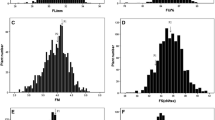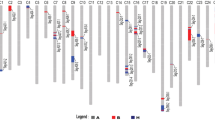Abstract
Introgressive breeding to introduce both obvious variation into a gene pool, and to unmask cryptic variation masked by close linkage or epistatic interactions, has repeatedly been attempted to improve fiber traits in Gossypium hirsutum by employing Gossypium barbadense as a donor parent. This study reports genetic variation for fiber quality traits in reciprocal advanced backcross populations between G. hirsutum cultivar Acala Maxxa and G. barbadense cultivar Pima S6. Micronaire (MIC), elongation (ELO), strength (STR), upper half mean length (UHM), and uniformity index (UI) showed significant genotypic variance, albeit different in the respective backgrounds for all traits except UI. Different levels of variation among genotypes for the same traits in reciprocal backgrounds suggest different levels of epistatic interactions, a hypothesis supported by a significant difference in transgressive segregants in Acala Maxxa and Pima S6 backgrounds. In Acala Maxxa background, 18, 18, 7, and 3 genotypes had significantly better MIC, ELO, STR and UHM, respectively, than Acala Maxxa. In Pima S6 background 10, 5, 8, and 11 genotypes had significantly better MIC, ELO, STR, and UHM, respectively, than Pima S6. Increased genetic variation and improved fiber quality in both backgrounds appears attainable using reciprocal introgression; however, the number of genotypes with simultaneous improvement for multiple fiber quality traits was higher in Acala Maxxa than Pima S6 background. Reciprocal populations provide a platform to study cytoplasmic effects on genetic variation and heritability of fiber quality traits, and estimate the size of base populations required to obtain genotypes with genetic gain by backcross breeding.
Similar content being viewed by others
References
Bowman DT (2000) Attributes of public and private cotton breeding programs. J Cotton Sci 4:130–136
Cantrell R, Davis D (2000) Registration of NM24016, an interspecific-derived cotton genetic stock. Crop Sci 40:1208
Cantrell R, Roberts C, Waddell C (2000) Registration ofAcala 1517-99′Cotton. Crop Sci 40:1200
Davis DD (1978) Hybrid cotton: specific problems and potentials. Adv Agron 30:129–157
D’Halluin K et al (2013) Targeted molecular trait stacking in cotton through targeted double-strand break induction. Plant Biotechnol J 11:933–941
Fryxell PA, Craven LA, McD J (1992) A revision of Gossypium sect. Grandicalyx (Malvaceae), including the description of six new species. Syst Bot 17:91–114
Gore MA, Percy RG, Zhang J, Fang DD, Cantrell RG (2012) Registration of the TM-1/NM24016 cotton recombinant inbred mapping population. J Plant Regist 6:124–127
Jiang CX, Chee PW, Draye X, Morrell PL, Smith CW, Paterson AH (2000) Multilocus interactions restrict gene introgression in interspecific populations of polyploid Gossypium (cotton). Evolution 54:798–814
Lacape J-M, Nguyen T (2005) Mapping quantitative trait loci associated with leaf and stem pubescence in cotton. J Hered 96:441–444
Lacape J-M et al (2005) QTL analysis of cotton fiber quality using multiple backcross generations. Crop Sci 45:123–140
May OL (1996) Genetic variation in fiber quality. Florence, USDA-ARS, Pee Dee Research and Education Center
May OL, Bowman DT, Calhoun DS (1995) Genetic diversity of US upland cotton cultivars released between 1980 and 1990. Crop Sci 35:1570–1574
Meredith WR, Bridge R (1971) Breakup of linkage blocks in cotton, Gossypium hirsutum L. Crop Sci 11:695–698
Moser CWSH, Oakley RGCSR (1999) History of cultivar development in the United States. Cotton 4:99
Patel JD et al (2014) Alleles conferring improved fiber quality from EMS mutagenesis of elite cotton genotypes. Theor Appl Genet 127:821–830
Paterson AH et al (2012) Repeated polyploidization of Gossypium genomes and the evolution of spinnable cotton fibres. Nature 492:423–427
Percy R (2001) Registration of PS-6ne, PS-6L [degrees], PS-6neL [degrees], P62ne, P62L [degrees], and P62neL [degrees] extra-long staple cotton germplasm. Crop Sci 41:602
Percy R (2002) Registration of five extra-long staple cotton germplasm lines possessing superior fiber length and strength. (Registrations of germplasm). Crop Sci 42:988–989
Percy RG (2009) The worldwide gene pool of Gossypium barbadense L. and its improvement. In: Paterson Andrew H (ed) Genetics and genomics of cotton. Springer, New York, pp 53–68
Percy R, Turcotte E (1997) Registration of 10 Pima cotton germplasm lines, P70–P79. Crop Sci 37:632–633
Percy R, Turcotte E (1998) Registration of extra-long staple cotton germplasm, 89590 and 8810. Crop Sci 38:1409
Percy R, Wendel JF (1990) Allozyme evidence for the origin and diversification of Gossypium barbadense L. Theor Appl Genet 79:529–542
Percy RG, Cantrell RG, Zhang J (2006) Genetic variation for agronomic and fiber properties in an introgressed recombinant inbred population of cotton. Crop Sci 46:1311–1317
Pro J (2012) v10 Cary. SAS, NC
Saha S, Wu J, Jenkins J, McCarty J, Hayes R, Stelly D (2011) Delineation of interspecific epistasis on fiber quality traits in Gossypium hirsutum by ADAA analysis of intermated G. barbadense chromosome substitution lines. Theor Appl Genet 122:1351–1361
SAS S (2011) for Windows Version 9.3 SAS Institute Inc, Cary, NC, USA
Shen X, Guo W, Lu Q, Zhu X, Yuan Y, Zhang T (2007) Genetic mapping of quantitative trait loci for fiber quality and yield trait by RIL approach in Upland cotton. Euphytica 155:371–380
Smith CW (1978) Bayes least significant difference: a review and comparison. Agron J 70:123–127
Smith CW, Coyle GG (1997) Association of fiber quality parameters and within-boll yield components in upland cotton. Crop Sci 37:1775–1779
Stelly D, Saha S, Raska D, Jenkins J, McCarty J Jr, Gutierrez O (2005) Registration of 17 upland (Gossypium hirsutum) cotton germplasm lines disomic for different G. barbadense chromosome or arm substitutions. Crop Sci 45:2663–2666
Tanksley S, Nelson J (1996) Advanced backcross QTL analysis: a method for the simultaneous discovery and transfer of valuable QTLs from unadapted germplasm into elite breeding lines. Theor Appl Genet 92:191–203
Tyagi P, Gore MA, Bowman DT, Campbell BT, Udall JA, Kuraparthy V (2014) Genetic diversity and population structure in the US Upland cotton (Gossypium hirsutum L.). Theor Appl Genet 127:283–295
Waghmare VN et al (2016) Comparative transmission genetics of introgressed chromatin in Gossypium (cotton) polyploids. Am J Bot 103:719–729
Wang G, Dong J, Paterson A (1995) The distribution of Gossypium hirsutum chromatin in G. barbadense germ plasm: molecular analysis of introgressive plant breeding. Theor Appl Genet 91:1153–1161
Wang B et al (2017) QTL analysis of cotton fiber length in advanced backcross populations derived from a cross between G. hirsutum and G. mustelinum. Theor Appl Genet 130:1–12
Wright S (1968) Evolution and the genetics of populations. Vol. 1. Genetic and biométrie foundations
Zhang Z et al (2011) QTL alleles for improved fiber quality from a wild Hawaiian cotton, Gossypium tomentosum. Theor Appl Genet 123:1075–1088
Acknowledgements
We sincerely thank the National Science Foundation for financial support. We further thank the members of the Plant Genome Mapping Lab and Molecular Cotton Breeding Lab for help in lab and field work.
Author information
Authors and Affiliations
Corresponding author
Ethics declarations
Conflict of interest
The authors declare that they have no conflicts of interest.
Rights and permissions
About this article
Cite this article
Chandnani, R., Zhang, Z., Patel, J.D. et al. Comparative genetic variation of fiber quality traits in reciprocal advanced backcross populations. Euphytica 213, 241 (2017). https://doi.org/10.1007/s10681-017-2029-7
Received:
Accepted:
Published:
DOI: https://doi.org/10.1007/s10681-017-2029-7




